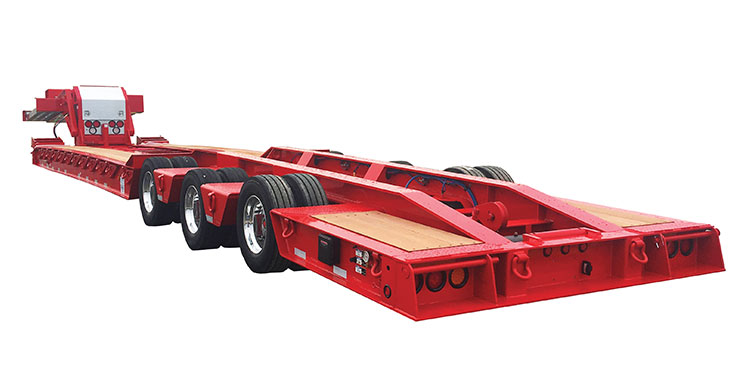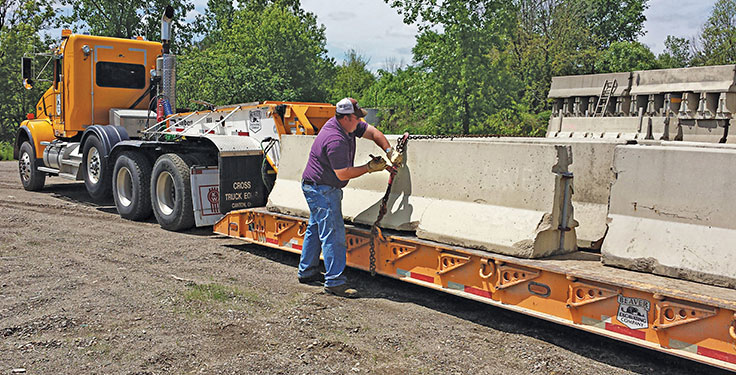
Heavy-haul trailers trek thousands of miles during their service lives, encountering a number of challenges.
From rocks and ruts to bumps and jolts, no trailer goes unscathed. To get the most out of trailers, here are some tips to prevent costly damage and keep trailers in tiptop shape.
Things to consider
1. The purchase. Minimizing heavy-haul trailer maintenance starts long before the load hits the road. To ensure long-term durability, choose units with high-strength steel, such as 12-in.-deep I-beams with a minimum yield strength of 100,000 psi.
High-quality finishes are also important. A trailer with premium primer and topcoat finishes will look great for years to come and will, as a result, have a higher resale value.
2. Load capacity. To minimize wear on components such as brakes and tires and to ensure safety, follow the right loading capacity for the trailer. This means getting a true idea of load concentrations, as well as weight, speed and safety ratings. Manufacturers are great resources for providing a clear picture of each trailer’s true capacity.
3. Pre-trip inspection. Before taking off with each load, inspect the heavy-haul trailer, checking that brakes and tires are in good condition. Also, ensure tires are properly inflated to the right psi, and confirm that hydraulic hoses are free from cracks or damage. If you’re operating a detachable or rear-load model, be sure to properly maintain hydraulic pressure – even on self-contained and wet lines.
A quick walk around the trailer to inspect the frame, chains and straps for damage is a good idea, as well. Trailers see a lot of use and abuse, particularly in harsher weather conditions. Repairs or replacements might be needed sooner rather than later.
4. Hydraulic cylinders. These should be fully retracted when not in use to minimize the stainless steel rams’ exposure to the elements and maximize their longevity.
5. Lubrication. Keep wheel ends lubricated to minimize wear and prevent gear oil leakage. Well-lubricated wheel ends also ensure proper and safe operation. Brakes, cams and slack adjusters need to be lubricated, as well.
In addition, use dielectric grease on lighting connections, electrical components, lights and lighting harnesses to reduce corrosion. Always refer to the manufacturer’s recommendations and grease guidelines.

6. Tires. Traveling with underinflated tires is one of the biggest culprits of premature wear, so keeping them properly inflated will allow them to last longer and boost fuel efficiency. Regularly check tire pressure and keep tires properly inflated, either manually or with an automatic tire inflation system.
In addition to keeping tires inflated, it’s equally important to replace them when they become worn to avoid a blowout and downtime. Always select the right size and rating to ensure optimal performance and keep tire pressure equalized for the greatest longevity.
7. Preventive maintenance program. Developing a preventive maintenance program that aligns with an owner’s business needs will minimize breakdowns and optimize longevity of trailers, as well as their components. It will also enhance safety.
Trailer fleet owners should match their equipment needs to a maintenance schedule. For example, will the trailer need to be on the road all the time, or will it sit idle for longer periods of time?
One of the best ways to see a direct reflection of the success of your maintenance program is through the Commercial Vehicle Safety Alliance’s (CVSA) inspection program. The nonprofit organization scores commercial motor vehicles based on inspection procedures and CVSA criteria – and the lower the number, the better.
8. Recordkeeping. Proper recordkeeping is also important so you know when preventive maintenance is needed and what’s already been done. This helps your operation optimize efficiency and prevent any small issues from becoming larger headaches down the road. Putting proper procedures in place will keep appropriate personnel accountable for performing the maintenance when needed.
9. Training/mechanics. Trailer owners should ensure that everyone involved with any aspect of a trailer’s use has proper training, not only to prevent damage to the trailer, but also for their safety and the safety of others. In addition, ensure mechanics are well trained to maintain heavy-haul trailers and that they follow manufacturer guidelines.
10. Communication. Drivers and maintenance technicians should have open lines of communication regarding trailer issues and required maintenance. This will ensure the right kind of maintenance is performed and that it’s done in a timely manner.
Final thoughts
From fleets of five trailers to 50, proper selection, maintenance and preventive programs are equally important to ensure the greatest longevity, safety and performance of units.
Troy Geisler is vice president of sales and marketing at Talbert Manufacturing while Lloyd Hair is director of maintenance at Keen Transport.











